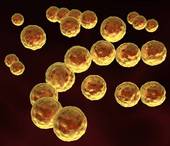Bacteria
One-celled microorganisms with both animal and plant characteristics.
Bacteria can exist anywhere! They can be found on skin, air, water, decayed matter, clothing, under the free edge of the nails, and body secretions. The two primary types of bacteria are:
Pathogenic and Nonpathogenic
First, we will look at Pathogenic Bacteria. These are considered harmful because they may cause disease or infection. Bacteria have different shapes that help identify them. Pathogenic bacteria have the following classifications:
1. Cocci- round-shaped that appear singly or in the following groups:
Staphylococci- Pus-forming bacteria that grow in clusters like a bunch of grapes. These cause boils, pustules , and abscesses.
Streptococci- Pus-forming bacteria arranged in curved lines that resemble a string of beads. They cause strep throat and blood poisoning.
Diplococci- Spherical bacteria that grow in pairs. They cause diseases such as pneumonia.


Staphylococci Streptococci
2. Bacilli- are short rod-shaped bacteria. They are the most common bacteria. They produce diseases such as tetanus, typhoid fever, tuberculosis, and diphtheria.

Bacilli
3. Spirilla- are spiral or corkscrew-shaped bacteria. They are divided into subgroups. They cause syphilis and Lyme disease.

Treponema papillida (syphilis)
Next we have Nonpathogenic Bacteria, which are completely harmless. They actually perform very useful functions such as helping break down our food for digestion, protect against infection, and stimulate the immune system.


